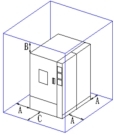
A constant temperature humidity chamber, also known as a climatic chamber, is a controlled environment used for testing and evaluating the performance of materials, components, and products under specific temperature and humidity cycling conditions. These chambers are used in a variety of industries, including electronics, automotive, aerospace, and medical device manufacturing.
Model: THS-250
Capacity: 250L
Shelf: 2 pcs
Color: Blue
Interior dimension: 600×500×810 mm
Exterior dimension: 1120×1100×2010 mm
The purpose of using a constant temperature and humidity test chamber is to test whether products can perform reliably and consistently under different environmental conditions, helping to identify any potential problems before the product is released to the market. You can click below video to learn details:
Specification
|
Model |
THS-50 |
THS-100 |
THS-150 |
THS-250 |
THS-500 |
THS-800 |
THS-1000 |
|
Interior Dimension |
350×320×450 |
500×400×500 |
500×500×600 |
600×500×810 |
800×700×900 |
1000×800×1000 |
1000×1000×1000 |
|
Exterior Dimension |
950×950×1400 |
1050×1030×1750 |
1050×1100×1850 |
1120×1100×2010 |
1350×1300×2200 |
1560×1410×2240 |
1560×1610×2240 |
|
Temperature Range |
0°C~+100°C |
||||||
|
Temperature Fluctuation: ≤±0.5°C; Temperature Uniformity: ≤2°C |
|||||||
|
Heating Rate |
2.0~3.0°C/min |
||||||
|
Cooling Rate |
0.7~1.0°C/min |
||||||
|
Humidity Range |
30% ~ 98% R.H (5%RH,10%RH also available) |
||||||
|
Humidity Bias |
+2/-3% R.H |
||||||
|
Interior Material |
SUS#304 brushed stainless steel |
||||||
|
Exterior Material |
Cold rolled steel plate with electrostatic spraying |
||||||
|
Insulation |
Superfine fiberglass wool / polyurethane foam |
||||||
|
Controller |
7” Programmable LCD touch screen controller |
||||||
|
Circulation System |
High temperature resistant motors, single cycle, long axis and stainless steel multi-leaf type centrifuge fan |
||||||
|
Humidification |
Shallow groove humidification, steam humidification mode, automatic water supply with water shortage alarm |
||||||
|
Dehumidification |
Refrigeration dehumidification mode |
||||||
|
Heating System |
NiCr heater, independent system |
||||||
|
Refrigeration |
France "TECUMSEH" Hermetic Compressors, Unit cooling mode/Dual cooling mode (air-cooling) |
||||||
|
Protection Devices |
Leakage and outage protection, compressor over-pressure, overheat, over-current protection, overload fusing protection,audio signal alarm, water shortage alarm |
||||||
|
Power Supply |
220V·50HZ/60HZ,380V 50HZ/60HZ |
||||||
Safety protection:
·Independent temperature limiter: An independent shutdown and alarm for thermal protection purpose during the test.
·Refrigeration system: Over-heat, over-current and over-pressure protection of compressor.
·Test chamber: Over-temperature protection, overheat of fan and motor, phase failure/reverse, timing of the entire equipment.
·Others: Leakage and outage protection, overload fusing protection, audio signal alarm, power leakage protection, and overload protection.
Temperature and humidity curve:
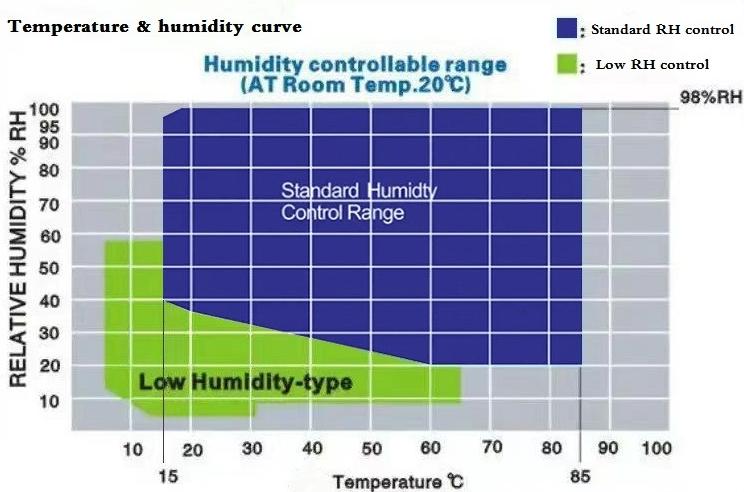
What is the structure of a constant temperature and humidity climatic test chamber?
The structure of a constant temperature and humidity test chamber varies depending on the manufacturer and model, but typically consists of the following main components:
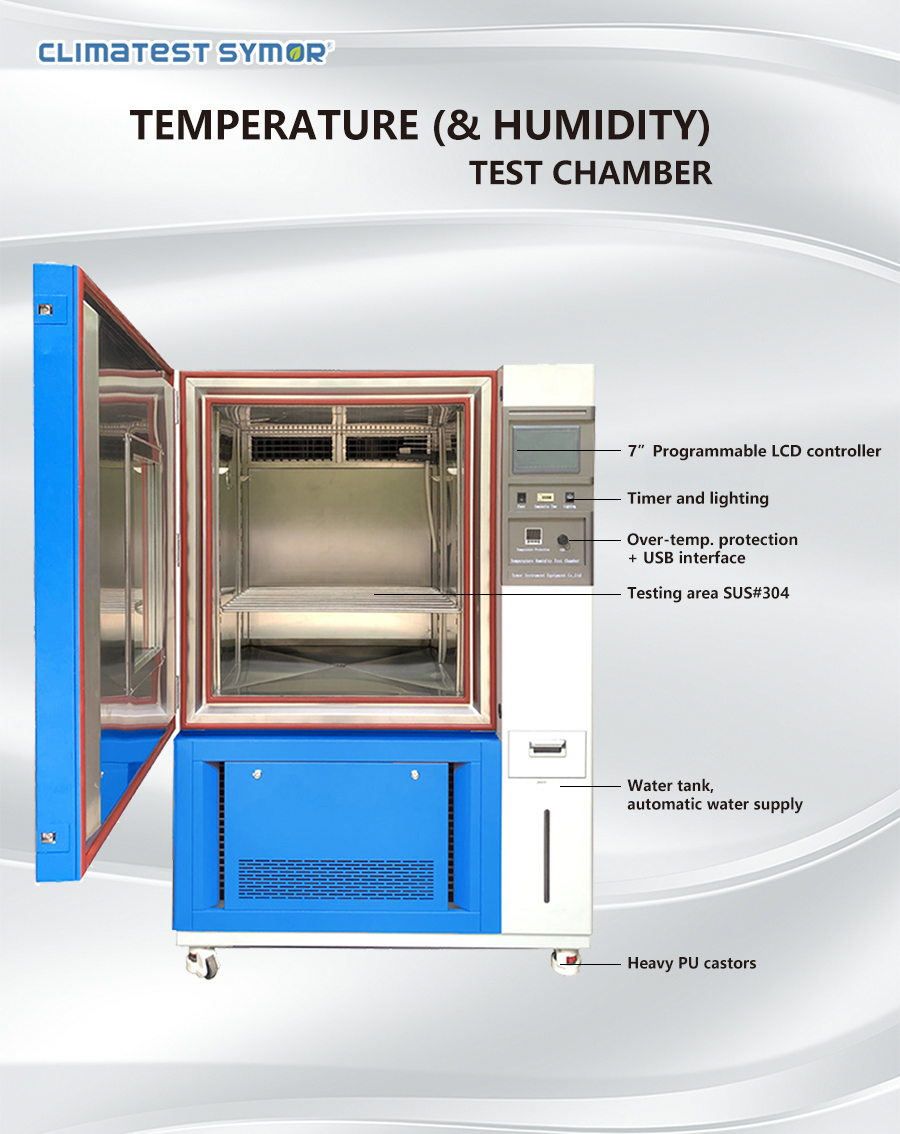
1. Working Chamber: This part is used to create a controlled environment for testing. The chamber is typically made of stainless steel SUS#304 that are durable enough to withstand the extreme temperature and humidity conditions inside.
2. Insulation: To maintain temperature and humidity levels, the chamber is typically insulated with materials such as fiberglass or polyurethane.
3. Heating and cooling system: This system adopts forced air convection to perform heating and cooling tests. To realize temperature humidity control, the test chamber should be able to carry out two functions: heating and cooling, uniform temperature also must be evenly distributed inside the working chamber, Climatest Symor® makes it possible to achieve a high degree of temperature uniformity in the whole testing area.
Constant temperature and humidity test chamber adopts mechanical cooling system and mechanical heating system to conduct testings on products:
Mechanical heating system consists of electric heating elements positioned near the ventilation system, so that the heated hot air is delivered into the testing zone from air inlet, then come out from air outlet, meanwhile, there are centrifugal fans located at the back of the air inlet, so as to blast the hot air to reach better uniformity.
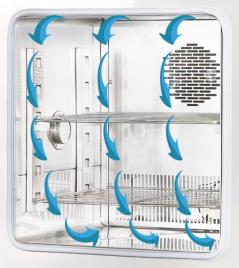
Mechanical cooling system consists of a closed circuit system, with the following main components:
·Control valve
·Condensor
·Evaporator
·Compressor

The refrigeration system in a thermal test chamber is classified to be single stage and double stage, the single stage is adopted with temperature -40℃ and above, and double stage (also called cascade system) is with temperature below 40℃.
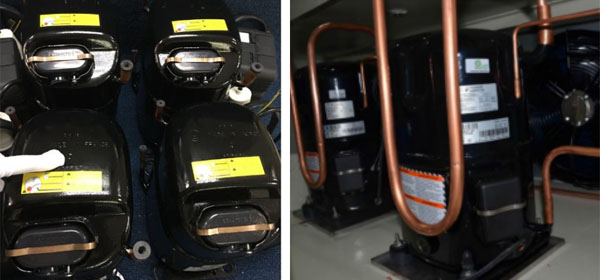
4.Humidity control system: The humidity control system is used to control the humidity inside the chamber. This system can include humidifying and dehumidifying systems.
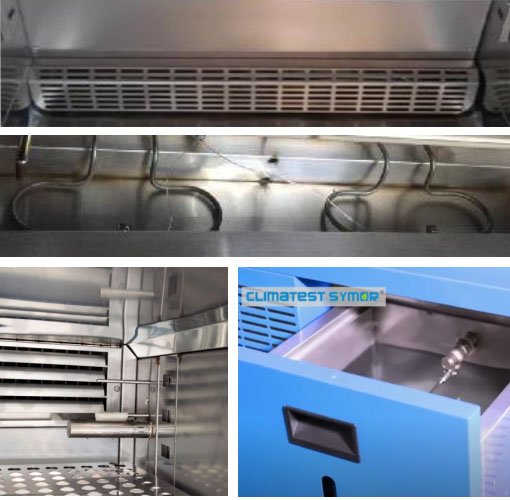
5. Control panel: The control panel is used to operate the test chamber. It typically includes a display for temperature and humidity readings, as well as buttons or knobs for adjusting the temperature and humidity levels.
Programmable LCD touch screen controller:
·7 inch Japan programmable touch screen controller
·Set temperature point under fix value mode or programs mode
·Temperature set point and realtime temperature curve display
·100 groups program with 999 segment memory; each segment 99Hour59Min
·Test data can be downloaded as required through RS232 interface

6. Sample holders: Sample holders are used to securely hold the products or materials being tested inside the chamber. These can be shelves, trays, or other types of holders, depending on the size and type of the products being tested.
7. Door: The door of the test chamber is used to access the interior. The door should be sturdy, airtight, and able to withstand the temperature and humidity conditions inside the chamber.
These are the main components of a constant temperature and humidity test chamber. The exact design and structure of the chamber can vary depending on the manufacturer and model, but these components are typically present in most models.
What is the price of a constant temperature and humidity climatic test chamber?
Constant temperature and humidity test chamber price can vary widely depending on several factors, such as the size of the chamber, the type of controls and features, and the manufacturer. It's important to consider not only the purchase price of the chamber, but also the long-term costs of operating and maintaining the chamber, including electrical usage, replacement parts, and servicing.
Ultimately, the cost of a constant temperature and humidity climatic test chamber will depend on the specific requirements of your application, and it's essential to carefully evaluate your needs and budget to determine the right chamber for your needs.
What is the application of a constant temperature and humidity climatic test chamber?
A constant temperature and temperature test chamber, also known as a thermal humidity chamber or a climate chamber, is a controlled environment used to simulate different temperature and humidity conditions for testing and evaluating various products and materials.
Some common applications of temperature humidity climatic chambers include:
1.Quality control: Constant temperature and humidity test chambers are used to test the performance and reliability of products under different temperature and humidity conditions. This helps manufacturers ensure that their products meet the required specifications and standards.
2.Research and development: Scientists and engineers use temperature humidity chambers to study the effects of temperature and humidity on various materials and products, allowing them to make improvements and advancements in their field.
3.Environmental testing: Many industries, including aerospace, automotive, and electronics, use constant temperature and humidity test chambers to test their products' performance in extreme temperature and humidity conditions, such as light, or hot and humid climates.
4.Medical and pharmaceutical testing: Constant temperature and humidity test chambers are used to test the stability and shelf life of medical and pharmaceutical products under various environmental conditions.
These are just a few examples of the many applications of constant temperature humidity chambers. By controlling temperature and humidity, temperature chambers provide a controlled environment for testing and evaluating a wide range of products and materials.
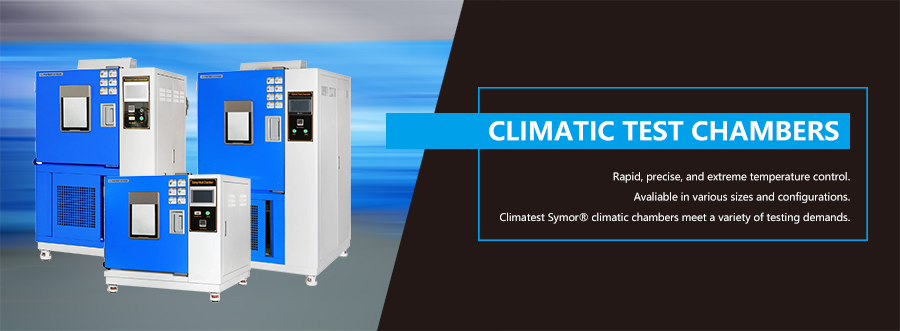
Packaging & shipment of a constant temperature and humidity climatic test chamber
The packaging and shipment of a constant temperature and humidity test chamber can impact its safety and performance. Proper packaging and shipment are important to prevent damage during transportation and ensure that the chamber arrives at its destination in good condition. Here are Climatest Symor® general guidelines for packaging and shipping a constant temperature and humidity test chamber:
1.Packaging materials: Use high-quality, shock-absorbing materials, such as foam or bubble wrap, to protect the chamber during transportation. You may also want to use a sturdy shipping crate to further protect the chamber.
2.Handling: The chamber is handled with care to prevent damage. It's important to use the right equipment, such as a forklift or pallet jack, to lift and move the chamber.
3.Labeling: Clearly label the chamber with "Fragile" and "This Side Up" stickers to ensure that it is handled with care during transportation.
4.Shipping method: The chamber is shipped by sea, Climatest Symor® team makes vessel booking in advance according to the size, weight, and destination of the chamber, the local transport is normally a truck.
It's important to work with a reliable and experienced shipping company to ensure that the constant temperature and humidity test chamber is packaged and shipped properly. Proper packaging and shipment can help ensure that the chamber arrives at its destination in good condition and is ready for use.

How to install a constant temperature and humidity climatic test chamber?
•Prepare the site: Choose a location that is near an electrical outlet. Make sure the floor is level and can support the weight of the chamber.
•Set up the electrical system: Connect the chamber to a power supply and make sure it is grounded. It is recommended to use a dedicated circuit for the chamber.
•Set up the ventilation system: The chamber needs to have adequate ventilation. Make sure there is enough air flow to circulate the air in the chamber.
•Install the chamber: The exact steps for installing the chamber will depend on the type and model of the chamber you have. Generally, the chamber will come with operation manual.
•Calibrate the chamber: The chamber is well calibrated before ex-factory, the user can test their common use temperature and humidity value to ensure the chamber is functioning correctly.
A: ≥60cm B: ≥60cm C: ≥120cm
Attention: inclination should not exceed 15°C
